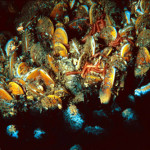I was worried that 2006 might pass without a sea change for deep-sea research until I ran across an article by Grasmueck et al in Journal of Geophysical Research that made my paradigm shift.
Recent deep surveys by the researchers from Rostenstiel School of Marine and Atmospheric Science at University of Miami used an autonomous underwater vehicle (AUV) to reveal more than 200 coral reefs in waters 600-800m deep off Grand Bahama Banks in the Straits of Florida. Following that, they used a drop camera to identify living scleractinian assemblages.
These findings support the case that deep coral reefs are widespread in the world’s ocean, perhaps even more than shallow coral reefs (Roberts et al 2006). These new bioherms in the Straits have yet to be explored by remote or human operated vehicles, but submersible surveys of other scleractinian mounds in the region (Reed et al 2005, 2006) describe these features as rich and diverse habitats for fish and invertebrates.
Unfortunately, this research may also support the case that robots are more useful than people. We’ll just have to learn to work harder, I guess. ; )
To read more about AUVs go here.
References:
Reed, J.K., S. Pomponi, A. Wright, D. Weaver, and C. Paull. 2005. Deep-water sinkholes and bioherms of South Florida and Pourtalès Terrace-habitat and fauna. Bull Mar Sci 77:267-296.
Reed, J. K., D. Weaver and S. Pomponi. 2006. Habitat and fauna of deep-water Lophelia pertusa coral reefs off the Southeastern USA: Blake Plateau, Straits of Florida, and Gulf of Mexico. Bull. Mar. Sci. 78: 343-375.
Roberts, JM, AJ Wheeler, and A Freiwald. 2006. Reefs of the Deep: The Biology and Geology of Cold-Water Coral Ecosystems. Science 28 April 2006 312: 543-547.






I wonder if they are be affected by some of the same diseases that are influencing shallow water corals – probably not, but it would be interesting to see how similar/dissimilar their diseases problems are with their shallow counterparts!
There was this redhead I knew…
never mind.